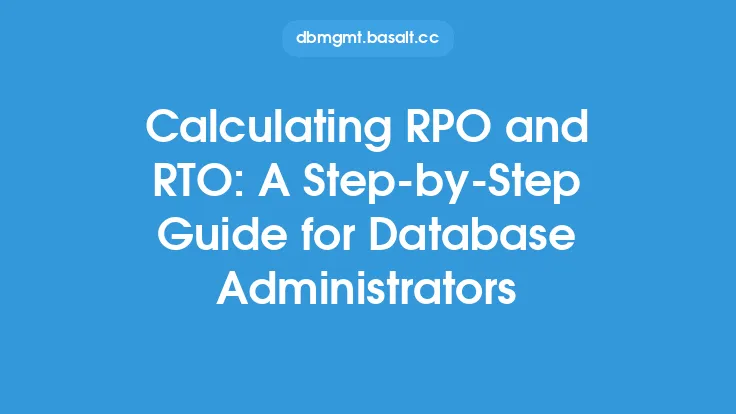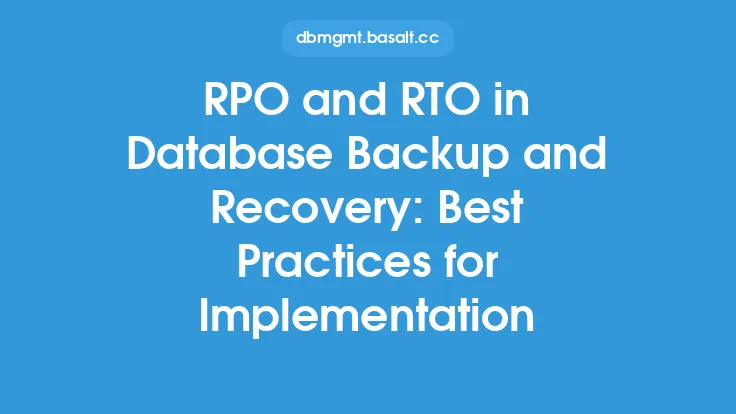When it comes to database management, two crucial concepts that play a significant role in ensuring data availability and minimizing downtime are Recovery Point Objective (RPO) and Recovery Time Objective (RTO). These two metrics are essential in determining the frequency and timing of database backups, as well as the speed at which data can be recovered in the event of a disaster or outage. In this article, we will delve into the key considerations for RPO and RTO in database management, exploring their importance, implications, and best practices for implementation.
Introduction to RPO and RTO
RPO and RTO are two interconnected yet distinct concepts that are used to measure the tolerance of an organization to data loss and downtime. RPO refers to the maximum amount of data that can be lost in the event of a disaster or outage, typically measured in terms of time. For example, an RPO of four hours means that the organization can tolerate losing up to four hours' worth of data. On the other hand, RTO refers to the maximum amount of time that an organization can afford to be without access to its data, typically measured in terms of hours or minutes. For instance, an RTO of two hours means that the organization needs to be able to recover its data and resume operations within two hours of an outage.
Understanding the Implications of RPO and RTO
The implications of RPO and RTO are far-reaching and can have a significant impact on an organization's operations, reputation, and bottom line. A high RPO can result in significant data loss, which can lead to financial losses, reputational damage, and even legal liabilities. On the other hand, a high RTO can result in prolonged downtime, which can lead to lost productivity, missed opportunities, and decreased customer satisfaction. Conversely, a low RPO and RTO can provide an organization with a competitive advantage, enabling it to respond quickly to changing market conditions, minimize downtime, and maximize data availability.
Key Considerations for RPO and RTO
When it comes to determining RPO and RTO values, there are several key considerations that organizations need to take into account. These include:
- Business requirements: The RPO and RTO values should be aligned with the organization's business requirements, taking into account factors such as data criticality, regulatory compliance, and customer expectations.
- Data types: Different types of data have different RPO and RTO requirements. For example, transactional data may require a lower RPO and RTO than archival data.
- System architecture: The RPO and RTO values should be aligned with the system architecture, taking into account factors such as data replication, redundancy, and failover capabilities.
- Resource constraints: The RPO and RTO values should be aligned with the organization's resource constraints, taking into account factors such as budget, personnel, and infrastructure.
Best Practices for Implementing RPO and RTO
Implementing RPO and RTO values requires a thorough understanding of the organization's business requirements, data types, system architecture, and resource constraints. Some best practices for implementing RPO and RTO include:
- Conducting regular risk assessments to identify potential threats to data availability and downtime.
- Developing a comprehensive disaster recovery plan that takes into account RPO and RTO values.
- Implementing data replication and redundancy mechanisms to minimize data loss and downtime.
- Conducting regular backups and testing data recovery procedures to ensure that RPO and RTO values can be met.
- Continuously monitoring and reviewing RPO and RTO values to ensure that they remain aligned with changing business requirements and system architectures.
Common Challenges and Pitfalls
Despite the importance of RPO and RTO, many organizations face common challenges and pitfalls when implementing these metrics. Some of these challenges include:
- Lack of understanding: Many organizations lack a clear understanding of RPO and RTO, which can lead to incorrect or unrealistic values being set.
- Insufficient resources: Implementing RPO and RTO values can require significant resources, including budget, personnel, and infrastructure.
- Inadequate testing: Many organizations fail to test their data recovery procedures, which can lead to RPO and RTO values not being met in the event of a disaster or outage.
- Inconsistent metrics: RPO and RTO values can be inconsistent across different systems and applications, which can lead to confusion and inefficiencies.
Conclusion
In conclusion, RPO and RTO are critical metrics that play a significant role in ensuring data availability and minimizing downtime in database management. By understanding the implications of RPO and RTO, taking into account key considerations, and implementing best practices, organizations can ensure that their data is available and accessible when needed. However, common challenges and pitfalls can arise, and it is essential for organizations to be aware of these and take steps to mitigate them. By doing so, organizations can minimize the risk of data loss and downtime, maximize data availability, and ensure that their database management systems are aligned with their business requirements.





